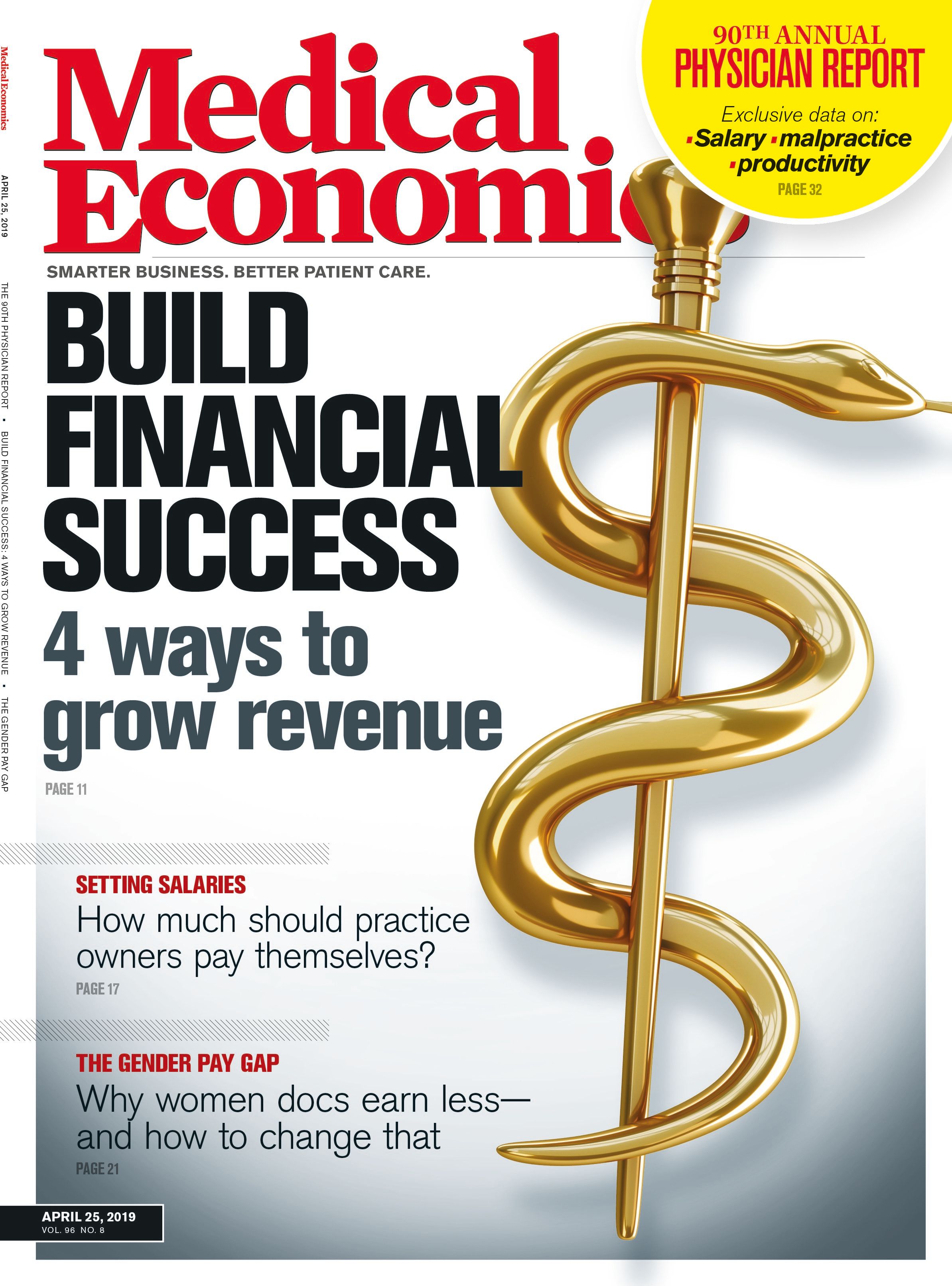Publication
Article
Medical Economics Journal
Best practices in setting your own salary
Author(s):
How much should practice owners pay themselves?
©Evlakhov Valeriy/Shutterstock.com

Physicians who own their own practices can enjoy a work-life environment that likely can’t be found if they were employed by a physician group or hospital system.
But the question of how much a physician practice owner should pay him or herself isn’t as easy to answer as it might seem. There are many factors that the owner must take into account, physicians and other experts say.
Physician practice owners have to understand they are business owners and revenue generators, says Kenneth T. Hertz, FACMPE, principal consultant for Medical Group Management Association (MGMA) Health Care Consulting Group. “As business owners, they have to step back and look at the practice from that point of view.”
Doctors prefer not to think of themselves as businesspeople first. “But it is often said, ‘no money, no mission,’” says Salvatore Volpe, MD, a practice owner in Staten Island, N.Y., and Medical Economics editorial advisory board member. “I’m trained as a physician, but I’ll go belly up if I don’t think like a businessman.”
Sometimes, thinking like a businessperson means taking a reduction in salary, paying themselves last or taking no salary at all for a period of time. There is the staff to think about; overhead costs, such as lease, utility and malpractice insurance payments; and investments in equipment needed to keep the practice up to date.
“There is no doubt that some practice owners resist the idea of paying themselves last,” Hertz points out. “The reality is that practice owners have to pay the staff first. Owners get paid last.”
Melissa E. Lucarelli, MD, FAAFP, a Medical Economics editorial advisory board member who runs a family practice in Randolph, Wis., agrees.
“I think of my employees’ salaries as being a fixed cost, comparable to the mortgage,” Lucarelli says. “There would never come a time when the mortgage isn’t paid. It’s the same with staff salaries. If I can’t afford to pay my staff, I have a problem.”
Once a practice is on sound financial footing, there are many variables, foreseen and unforeseen, that play a role in salary, says Jeffrey Kagan, MD, a majority owner of a two-physician practice in Newington, Conn., and Medical Economics editorial advisory board member.
“The lifestyle of physicians is a factor, as is the type of practice they want,” Kagan points out. “It also depends on how many patients owners want to see on a daily basis and how much time they want to spend with those patients.”
Plan ahead
To keep the other physicians in the group and staff happy and to be sure there is ample revenue to reinvest in the practice, owners should always have a salary plan, Kagan says.
In anticipation of the next year, Kagan says, his practice’s accountant creates a budget based on the revenue from the previous two years. Since salary is partially based on productivity, two years is taken into consideration so if Kagan or his partner don’t produce as much revenue as expected, the decrease in income is more gradual, he
explains.
At the same time, the accountant tries to predict whether practice expenses will be higher or lower for the coming year. Kagan bases the amount of salary he will receive on this forecast.
“If we know we have a costly capital expense coming up, we add that to the calculation,” he says. “As we go through the year, we’ll give ourselves bonuses if there is extra money. If there’s not enough money, the partners miss a paycheck.
“The staff always gets paid,” he adds. “But there have been times when our physicians miss a paycheck. We take a check every two weeks, so sometimes there will be a month where we only get one check.”
Their accountant reviews the practice’s numbers each quarter. “As we go through the year, if there is extra money, we bonus ourselves,” Kagan says. “If there is not extra money, we miss a paycheck.”
Dave Gans, MSHA, FACMPE, senior fellow, industry affairs for MGMA, says physicians who own their own practices don’t receive salaries in the traditional sense.
Instead, physicians take what is called a draw, the revenue that’s left after practice expenses are calculated. The owner takes a percentage of the excess revenue on a predetermined bi-weekly or other periodic basis with occasional adjustments based on the practice’s financial statement.
The amount of the draw is based on the profits, not the percentage. The percentage is based on the number of shareholders or partners and whether the shareholders or partners have equal or unequal shares of the business. For example, if four doctors are equal partners, each will take one-fourth of the excess, if there are three partners, each will take one-third.
“You want to be able to pay salaries within the context of [the practice’s] market,” Gans says.
The owners’ draws are the same as a salary, and they can choose the timing for when to reconcile their periodic biweekly or monthly draws to the total profits. Most practices do this quarterly, so they can adjust their draw higher or lower to avoid a “December surprise.”
However, there is no reason why the owners couldn’t choose to wait until the end of the year and take the distribution as a single payment, Gans says. As to leaving the profits in the business, the legal organization determines whether this is possible.
Lucarelli, who has run her family practice since 2001, says a financial consultant advised her early on that her salary should be within the market range.
“It doesn’t mean you pay yourself the highest amount of money for your particular type of practice in the region,” she says. “But you can put yourself in the ballpark of the average salary.”
Since opening her practice, Lucarelli says, she reviews regional salary surveys and adjusts her pay accordingly. A good source to reference, she says, is Doximity’s salary survey, which is broken down by region and metropolitan area.
Salary equals lifestyle
In a short period of time, physicians can go from residency to owning a practice with a six-figure salary. Thus it’s important to have a good financial strategy, including a personal budget and retirement plan.
“I’ve seen practices where the partners are overextended through personal issues,” Hertz says. “When a practice gets into a difficult financial situation and money starts to get tight, you start to discuss salary. That’s when the personal financial needs of the individual physician rise up to a high level and get in the way of having reasonable discussions of what compensation ought to be.”
Starting and contributing to a “rainy day fund” is also important for times when reimbursements are slow and money becomes tight, Hertz advises. The fund can help owners avoid borrowing against the practice to meet payroll or monthly expenses.
The easiest way to create a rainy day fund is for physicians and management to agree on an amount of money to set aside every month for future protection, Hertz says. This is similar to placing money in a savings account for personal finances, before it even makes it into your checking account. At the end of the year, absent any special needs or emergencies, the funds are distributed to physicians along the lines of the compensation plan.
Developing a budget for compensation is based on several factors, Hertz notes. The practice must understand the relationship between what the physician wants to earn and how hard they want to work. More work equals more production, more production equals more revenue, more revenue equals the ability to earn a larger salary.
Researching industry normative data, such as the MGMA Physician Compensation Survey, is a good way to understand the relationship between productivity and compensation, as well as getting a good understanding of what’s happening in the industry.
The other piece of compensation is a pretty simple formula: Revenue minus expenses equals compensation, where expenses represent all the costs of running the practice. Since physician owners are paid last in a very simplistic way, they receive what is left at the end of the day, Hertz says. “This is why financial planning is so important,” he points out.
The practice itself has to be a consideration. “An owner can’t drain the checkbook for a salary,” he cautions. “There won’t be anything left to cover unforeseen circumstances or for capital expenses.”
Startup costs have a bearing on salaries
Opening a practice is just like opening any other type of small business. There are capital expenditures – purchasing equipment, renting space, hiring staff, etc. – that will impact how long before the practice becomes profitable.
Typically, physicians won’t initially take a salary if they’re investing in a new practice, says Erik Doerr, CPA, partner and tax manager for Enestvedt & Christensen, LLP of Burnsville, Minnesota. They are allowed to loan the company funds to cover initial startup costs. As revenue increases and physicians see the need to continue to invest, they can continue to loan the business money if they don’t want to borrow it.
There are capital contributions and loans from investors or owners. In a single-owner operation, it’s easier to call it capital contributed to the business instead of a loan, Doerr says.
“We typically recommend that capitalization is done by utilizing a low stock purchase with one or more promissory notes.” he says. “When a profit is generated, those notes would be paid off. The cash can be taken out of the business as a repayment of those notes instead of a distribution or draw.”
New practices typically lose money for at least the first one to two years while they build a patient base and invest in operations, Doerr says.
During that time, practice owners have control over how much salary they can take. However, Doerr points out, practice owners are allowed to skip taking a salary where there is a reasonable basis for doing so.
“I normally recommend that owners avoid taking a high, regular salary until the business becomes profitable,” he says. “Taking a salary on day one when you’re not profitable does not make sense.”
“If a physician elects not to take a salary, they must ensure that they have adequate savings to fund the business, as well as their personal financial obligations,” Doerr adds.
There are many variables to consider for physicians contemplating their own practice. The first consideration should be to establish reasonable expectations. Then, create a vision and plan for how to proceed – “mapping out the road you want to travel,” says Kenneth T. Hertz, FACMPE, principal consultant for Medical Group Management Association (MGMA) Health Care Consulting Group.
“It can be tremendously rewarding [owning a practice],” Hertz stresses. “But it will be hard work. It absolutely can and will be rewarding if done properly. And the physician can build wealth.”






























